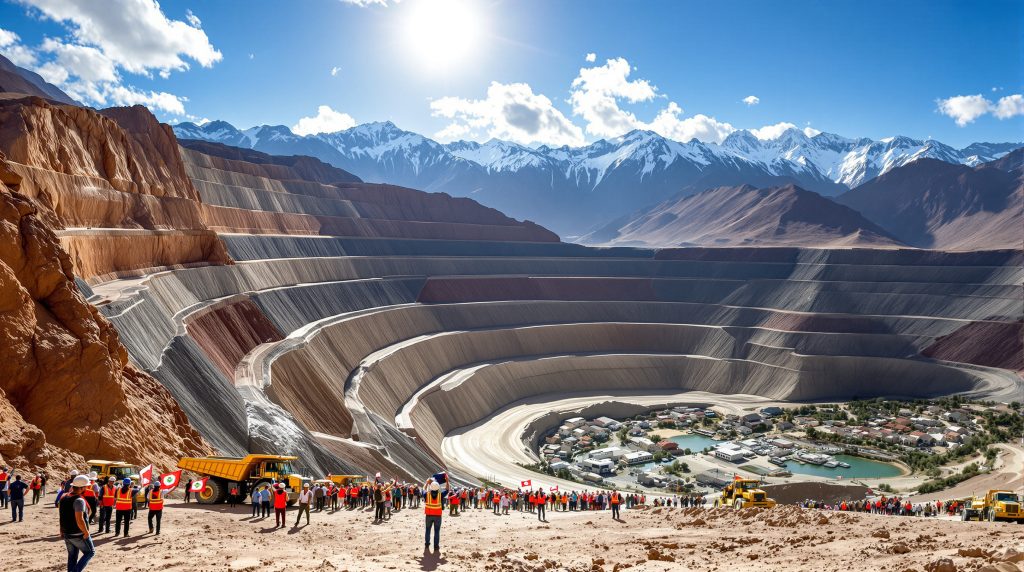Hudbay Peru Mine Protests: Understanding the Conflict and Resumption of Operations
Hudbay Minerals has announced the resumption of operations at its Constancia copper mine in Peru following disruptions caused by community protests. The Canadian mining company faced operational challenges when local blockades prevented access to the site, temporarily halting production activities. As Peru continues to navigate the complex relationship between mining operations and local communities, this recent event highlights the ongoing tensions in one of the world's largest copper-producing regions.
What Happened at Hudbay's Constancia Mine in Peru?
The Constancia copper mine experienced a significant operational disruption that began in late September 2025 when local community protests resulted in blockades preventing access to the mining facility. Hudbay Minerals announced on October 8, 2025, that operations have now resumed after approximately two weeks of shutdown.
During the temporary closure, the company suspended production activities to ensure worker safety while local authorities worked to address the underlying tensions with community groups. The disruption affected the company's production schedule, notably delaying a 20,000 dry-metric-tonne concentrate shipment that had been planned for late September.
According to company statements, Hudbay strategically used the downtime to perform preventive maintenance on mill equipment and mining machinery, helping to mitigate some of the production impacts. The shipment has been rescheduled for early October, with the company noting that while third-quarter sales volumes were temporarily affected, their overall 2025 production guidance remains unchanged.
Why Do Mining Protests Occur in Peru?
Historical Context of Mining Conflicts
Peru's position as one of the world's leading copper producers has made mining a cornerstone of the national economy. However, this economic prominence has often come with social friction. The relationship between mining companies and local communities in Peru has been characterized by recurring conflicts spanning decades, with disputes typically centered around several fundamental issues:
-
Environmental concerns: Communities frequently express fears about water contamination, soil degradation, and damage to local ecosystems
-
Economic benefit distribution: Questions about how mining revenues are shared between companies, the national government, and local communities
-
Community consultation: Disputes over the adequacy of consultation processes and whether true informed consent was obtained
-
Land rights: Disagreements regarding traditional territorial claims and access to resources
-
Infrastructure and social development: Expectations around mining companies' contributions to local development projects
These tensions exist within a complex historical context where many communities have experienced unfulfilled promises from both government and corporate entities regarding development benefits.
Recent Trends in Mining Protests
Mining conflicts in Peru have displayed increasing complexity in recent years. The southern mining corridor, where Constancia is located, has been particularly affected by community actions. These protests typically manifest as:
-
Strategic road blockades targeting key access points to mining operations
-
Community mobilizations demanding direct dialogue with senior company executives
-
Public demonstrations highlighting environmental monitoring concerns
-
Calls for renegotiation of existing social benefit agreements
-
Coordinated actions across multiple communities sharing similar grievances
According to local observers, these protests often reflect deeper governance challenges around resource management and benefit-sharing in resource-rich regions. Mining-dependent regions frequently display striking contrasts between significant mineral wealth extraction and persistent local poverty, creating conditions ripe for social conflict.
How Did the Constancia Mine Shutdown Impact Operations?
Operational Disruptions
The temporary shutdown at Constancia created several operational challenges for Hudbay:
-
Complete production halt: The inability to access the site forced a total suspension of copper concentrate production
-
Logistics complications: The delayed shipment of 20,000 dry-metric-tonnes of concentrate disrupted supply chain schedules
-
Sales impact: Temporary reduction in third-quarter sales volumes due to the inability to transport finished product
-
Workforce management challenges: Need to adjust workforce schedules and deployment plans during the unplanned closure
-
Safety protocols activation: Implementation of emergency safety procedures to protect assets and personnel
According to mining industry analysts, even short-term disruptions can create ripple effects throughout integrated mining operations, affecting everything from production schedules to financial performance metrics.
Strategic Adaptations During Shutdown
Despite the unplanned nature of the shutdown, Hudbay implemented several strategic measures to minimize the impact:
-
Preventive maintenance acceleration: The company used the downtime to conduct maintenance on mill equipment that would otherwise have required planned shutdowns
-
Equipment servicing: Mining machinery received servicing that helped offset some productivity losses
-
Operational planning: Management developed contingency plans for rapid resumption once access was restored
-
Stakeholder communication: Maintained regular updates with investors, employees, and other stakeholders
-
Logistics rescheduling: Reorganized shipping schedules to accommodate the delayed concentrate shipment
This strategic approach to managing the disruption demonstrates how modern mining industry innovation has developed increasingly sophisticated responses to what has become a recurring challenge in the Peruvian mining sector.
What Is the Constancia Mine's Significance?
Mine Profile and Production Capacity
The Constancia operation represents one of Hudbay's flagship assets and a significant contributor to Peru's copper sector:
| Feature | Details |
|---|---|
| Location | Chumbivilcas province, southern Peru |
| Type | Open-pit copper mine |
| Ownership | 100% Hudbay Minerals |
| Production | Primary copper with molybdenum, silver and gold by-products |
| Processing Capacity | Approximately 90,000 tonnes per day |
| Operating Since | 2014 |
| Mine Life | 15+ years (remaining) |
| Elevation | 4,100-4,600 meters above sea level |
| Recovery Methods | Conventional crushing, grinding and flotation |
The mine's high-altitude location in the Andes creates both operational challenges and strategic advantages, with access to significant mineral resources but complex logistics and environmental considerations.
Economic Importance
Constancia plays a crucial role in both the regional economy and Hudbay's corporate performance:
-
Employment generation: The mine directly employs hundreds of workers and creates thousands of indirect jobs
-
Regional economic driver: Serves as an economic anchor for the Chumbivilcas province
-
Export contribution: Represents a significant component of Peru's copper export sector
-
Revenue significance: Functions as a key revenue generator for Hudbay's global operations
-
Supply chain impact: Supports numerous local and national businesses through procurement activities
-
Tax revenue: Contributes substantial tax and royalty payments to local and national governments
Industry analysts note that established mines like Constancia are particularly valuable in the current market environment, where developing new copper projects faces increasing regulatory, capital, and social license challenges globally. Recent copper price insights suggest that these operations will remain economically significant for years to come.
How Has Hudbay Managed Community Relations?
Community Engagement Approaches
Hudbay has implemented various community relations strategies at Constancia, including:
-
Social investment programs focusing on education, healthcare, and local infrastructure development
-
Local procurement policies designed to maximize economic benefits for regional businesses
-
Skills development initiatives providing training and employment pathways for community members
-
Participatory environmental monitoring involving community representatives in water and air quality testing
-
Regular dialogue mechanisms establishing formal channels for community concerns and feedback
-
Cultural heritage protection efforts recognizing and preserving important cultural sites
-
Agricultural support programs helping local farmers improve productivity and market access
These approaches reflect mining industry evolution toward more comprehensive community engagement models that go beyond traditional corporate social responsibility frameworks.
Challenges in Stakeholder Management
Despite these efforts, several challenges have persisted in managing community relationships:
-
Multiple stakeholder groups with varying and sometimes conflicting interests and expectations
-
Historical grievances predating current ownership that continue to influence community perceptions
-
Evolving expectations as communities become more sophisticated in their engagement with mining companies
-
Political influence where local and regional political actors may leverage mining issues for their agendas
-
Trust deficits resulting from past experiences with other mining operations or government entities
-
Communication barriers including linguistic, cultural, and educational differences
-
Benefit distribution disputes regarding how mining advantages are shared across different communities
Mining industry observers note that successful community relations in Peru increasingly require nuanced, long-term approaches that address both historical concerns and evolving community expectations. This often includes considerations for effective mine reclamation innovation to address environmental concerns.
What's Next for the Constancia Operation?
Resumption Timeline and Expectations
According to Hudbay's official announcement, the resumption of operations will follow a structured approach:
-
Mill operations: Have already returned to full production capacity
-
Workforce normalization: Expected to reach standard levels over the coming days
-
Shipment rescheduling: The delayed concentrate shipment has been rescheduled for early October
-
Production recovery: Operational adjustments to recover from the temporary production gap
-
2025 guidance maintenance: The company maintains its production and cost guidance for 2025 despite the disruption
The relatively swift resumption suggests effective contingency planning and stakeholder management protocols were in place to address this type of disruption.
Future Risk Mitigation Strategies
To reduce the likelihood of similar disruptions moving forward, mining companies operating in Peru's challenging social environment are likely to focus on:
-
Early warning systems: Enhancing capacity to identify emerging community concerns before they escalate
-
Dialogue strengthening: Building more robust communication channels with diverse community groups
-
Benefit agreement reviews: Periodically revisiting community agreements to ensure they remain relevant
-
Government coordination: Improving alignment with local, regional and national authorities
-
Contingency planning: Developing more comprehensive operational responses to potential disruptions
-
Community capacity building: Supporting community governance to enable more effective dialogue
-
Transparent communication: Ensuring clear, accessible information about environmental performance and economic contributions
Industry specialists suggest that proactive engagement strategies that address underlying socioeconomic issues may prove more effective than reactive approaches focused solely on resolving immediate conflicts.
How Common Are Mining Protests in Peru?
Recent Pattern of Mining Conflicts
Peru has experienced numerous mining-related protests in recent years, affecting multiple operations across the country:
-
Las Bambas copper mine operated by MMG Limited has faced repeated blockades and community actions
-
Southern Copper's Tía María project encountered significant opposition that delayed development for years
-
Anglo American's Quellaveco project experienced community protests during its construction phase
-
Antamina copper mine (BHP/Glencore) has navigated periodic community conflicts
-
Smaller mining operations throughout the country have faced intermittent community actions
The prevalence of these conflicts has led some industry analysts to refer to social license issues as a "structural challenge" within Peru's mining sector rather than isolated incidents. The situation mirrors challenges seen elsewhere, such as the recent Namibia mining halt that affected uranium production.
Factors Contributing to Mining Tensions
Several systemic factors contribute to the recurring nature of mining conflicts in Peru:
-
Governance challenges in effectively regulating the mining sector and ensuring compliance
-
Historical inequality creating context where resource extraction is viewed through a lens of past exploitation
-
Environmental concerns regarding water usage and potential contamination in agriculturally important regions
-
Cultural differences between corporate and community perspectives on land use and development
-
Political fragmentation complicating resolution processes at local, regional and national levels
-
Information asymmetries where communities may lack access to technical information about mining impacts
-
Benefit distribution mechanisms that sometimes fail to deliver tangible improvements to local quality of life
Understanding these underlying factors is crucial for developing more effective approaches to preventing and resolving mining conflicts in Peru's complex socio-political landscape.
What Are the Broader Implications for Mining in Peru?
Investment Climate Considerations
The pattern of mining protests in Peru raises several considerations for the investment climate:
-
Risk assessment evolution: Investors increasingly incorporate sophisticated social risk analysis into decision-making
-
Valuation impacts: Projects with strong community relations may command premium valuations
-
Capital allocation decisions: Companies may prioritize jurisdictions with more predictable social environments
-
Operational cost calculations: Social license maintenance is increasingly budgeted as a core operational expense
-
Due diligence expansion: Acquisition processes now routinely include detailed community relations assessments
-
Insurance implications: Insurers are developing more nuanced approaches to covering social disruption risks
-
ESG integration: Environmental, Social, and Governance factors play an increasingly central role in investment decisions
Mining finance specialists note that while Peru's mineral endowment remains highly attractive, social license considerations have become a critical factor in investment decision-making. This has implications for global copper investment insights as investors navigate political risk.
Regulatory and Policy Environment
Peru's government faces ongoing challenges in balancing mineral development with social concerns:
-
Consultation frameworks: Pressure to strengthen and clarify processes for meaningful community consultation
-
Revenue distribution: Ongoing debates about how mining taxes and royalties are allocated between national and local levels
-
Environmental oversight: Questions about regulatory capacity to effectively monitor compliance
-
Institutional coordination: Challenges in aligning different government agencies involved in mining oversight
-
Legal certainty: Concerns about potential changes to mining legislation creating regulatory uncertainty
-
Mediation capacity: Limited government resources for effective conflict prevention and resolution
-
Development planning: Need for improved integration of mining into broader regional development strategies
Policy experts suggest that addressing these governance challenges will be crucial for Peru to maintain its position as a leading mining jurisdiction while improving social outcomes in mining regions.
FAQ: Hudbay Peru Mine Protests
What caused the protests at Hudbay's Constancia mine?
While specific details about the recent protests weren't fully disclosed, mining conflicts in Peru typically involve concerns about environmental impacts, economic benefit distribution, consultation processes, and land rights issues within affected communities.
How long was the Constancia mine shut down?
The mine was shut down for approximately two weeks in late September to early October 2025, with operations resuming on October 8 according to company announcements.
Will the shutdown affect Hudbay's annual production targets?
According to company statements, Hudbay expects to maintain its 2025 production and cost guidance despite the temporary disruption, suggesting they believe the impact can be managed within existing operational flexibility.
What steps did Hudbay take during the shutdown?
Hudbay utilized the downtime to perform preventive maintenance on mill and mining equipment, helping to mitigate some of the production impact while preparing for a rapid resumption once access was restored.
Are mining protests common in Peru?
Yes, Peru has experienced numerous mining-related protests in recent years, with blockades and community actions affecting multiple operations across the country's mining sector, making social license a persistent challenge for operators.
How important is the Constancia mine to Hudbay's overall operations?
The Constancia mine is a significant asset in Hudbay's portfolio, representing one of the company's primary copper producing operations globally and an important contributor to the company's financial performance.
What environmental concerns do communities typically raise about mining in Peru?
Communities frequently express concerns about water quality and availability, particularly in agricultural regions where water is crucial for livelihoods, as well as air quality, soil contamination, and biodiversity impacts.
How does the Peruvian government typically respond to mining protests?
Government responses have varied widely, ranging from mediation efforts to deployment of security forces, often depending on the political context, the specific nature of protests, and the economic significance of the affected operation.
Further Exploration:
Readers interested in learning more about mining conflicts in Peru can explore related educational content from Mining Weekly, which offers additional reporting on mining industry developments in South America and global mining trends affecting copper production.
Interested in Catching the Next Major Mineral Discovery Before the Market?
Discovery Alert's proprietary Discovery IQ model delivers instant notifications when significant ASX mineral discoveries occur, helping you capitalise on potentially transformative opportunities before the broader market. Explore how historic discoveries have generated substantial returns by visiting the dedicated discoveries page and position yourself for your next mining investment success.




